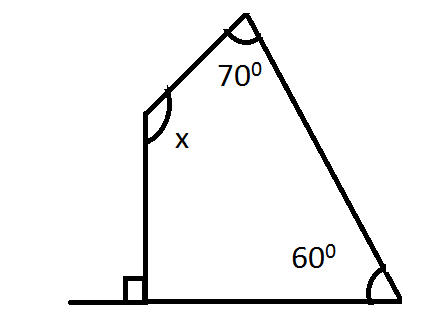
Answer
469.8k+ views
Hint: The Quadrilateral or quadrangle is a shape with four sides. to be considered as a quadrangle. the shape must
1) Have four straight sides
2) Be a flat shape (2dimentional)
3) Be a closed figure.
4) Edges and vertices \[ = {\text{ }}4\]
The word quadrilateral is derived from the Latin word quadric, a variant of four sides and the latus meaning side quadrilateral are either convex or concave.
The interior angle of a simple quadrilateral ABCD adds up to \[{360^0}\;\]arc.
i.e. \[\angle A + {\text{ }}\angle {\text{ }}B{\text{ }} + {\text{ }}\angle {\text{ }}C{\text{ }} + {\text{ }}\angle {\text{ }}D = {\text{ }}{360^0}\].
Any quadrilateral that is not self-intersecting is a simple quadrilateral
Trapezium, Isosceles trapezium Parallelogram, Rhombus, Rhomboid Rectangle, Square, oblong, Kite tangential Quadrilateral, Tangent of trapezoid, cyclic Quadrilateral, Right Kite, Harmonic Quadrilate Bicentric Quadrilateral, Orthodiagonal, Oceadrilateral, Equidiagonal Quadrilateral are all different type of Quarilaterlas.
Complete step by step answer:
According to the question, there are 4 Angles in a Quadrilateral.
Let\[\angle {\text{ }}A = 90,{\text{ }}\angle {\text{ }}B = {\text{ }}x,{\text{ }}\angle {\text{ }}C = {\text{ }}70,\angle {\text{ }}D = {\text{ }}60\].
Since in quadrilateral sum of interior angles is equal to 3600.
\[\angle {\text{ }}A{\text{ }} + {\text{ }}\angle {\text{ }}B{\text{ }} + {\text{ }}\angle {\text{ }}C{\text{ }} + {\text{ }}\angle {\text{ }}D = {360^0}\]
\[90 + {\text{ }}x{\text{ }} + {\text{ }}70{\text{ }} + {\text{ }}60{\text{ }} = {360^0}\]
\[\;\left( {90{\text{ }} + {\text{ }}60} \right){\text{ }} + {\text{ }}x{\text{ }} = {\text{ }}360{\text{ }} - 70\]
\[150{\text{ }} + {\text{ }}x{\text{ }} = 290\]
\[x{\text{ }} = {\text{ }}290{\text{ }}-{\text{ }}150\]
\[x{\text{ }} = {\text{ }}140\]
\[\angle {\text{ }}B = 140\]
Note: A quadrilateral is a shape of \[4\] sides for which any quadrilateral we draw a diagonal line to divide it into two triangles. Each triangle has an angle sum of \[180\]degree.
Therefore, the total angle sum of a quadrilateral is\[360\]. A quadrilateral cannot have \[3\] Obtuse angle where an obtuse angle is an angle that has a measure that is greater than\[{90^0}\].
1) Have four straight sides
2) Be a flat shape (2dimentional)
3) Be a closed figure.
4) Edges and vertices \[ = {\text{ }}4\]
The word quadrilateral is derived from the Latin word quadric, a variant of four sides and the latus meaning side quadrilateral are either convex or concave.
The interior angle of a simple quadrilateral ABCD adds up to \[{360^0}\;\]arc.
i.e. \[\angle A + {\text{ }}\angle {\text{ }}B{\text{ }} + {\text{ }}\angle {\text{ }}C{\text{ }} + {\text{ }}\angle {\text{ }}D = {\text{ }}{360^0}\].
Any quadrilateral that is not self-intersecting is a simple quadrilateral
Trapezium, Isosceles trapezium Parallelogram, Rhombus, Rhomboid Rectangle, Square, oblong, Kite tangential Quadrilateral, Tangent of trapezoid, cyclic Quadrilateral, Right Kite, Harmonic Quadrilate Bicentric Quadrilateral, Orthodiagonal, Oceadrilateral, Equidiagonal Quadrilateral are all different type of Quarilaterlas.
Complete step by step answer:
According to the question, there are 4 Angles in a Quadrilateral.
Let\[\angle {\text{ }}A = 90,{\text{ }}\angle {\text{ }}B = {\text{ }}x,{\text{ }}\angle {\text{ }}C = {\text{ }}70,\angle {\text{ }}D = {\text{ }}60\].
Since in quadrilateral sum of interior angles is equal to 3600.
\[\angle {\text{ }}A{\text{ }} + {\text{ }}\angle {\text{ }}B{\text{ }} + {\text{ }}\angle {\text{ }}C{\text{ }} + {\text{ }}\angle {\text{ }}D = {360^0}\]
\[90 + {\text{ }}x{\text{ }} + {\text{ }}70{\text{ }} + {\text{ }}60{\text{ }} = {360^0}\]
\[\;\left( {90{\text{ }} + {\text{ }}60} \right){\text{ }} + {\text{ }}x{\text{ }} = {\text{ }}360{\text{ }} - 70\]
\[150{\text{ }} + {\text{ }}x{\text{ }} = 290\]
\[x{\text{ }} = {\text{ }}290{\text{ }}-{\text{ }}150\]
\[x{\text{ }} = {\text{ }}140\]
\[\angle {\text{ }}B = 140\]
Note: A quadrilateral is a shape of \[4\] sides for which any quadrilateral we draw a diagonal line to divide it into two triangles. Each triangle has an angle sum of \[180\]degree.
Therefore, the total angle sum of a quadrilateral is\[360\]. A quadrilateral cannot have \[3\] Obtuse angle where an obtuse angle is an angle that has a measure that is greater than\[{90^0}\].
Recently Updated Pages
10 Examples of Evaporation in Daily Life with Explanations

10 Examples of Diffusion in Everyday Life

1 g of dry green algae absorb 47 times 10 3 moles of class 11 chemistry CBSE

If x be real then the maximum value of 5 + 4x 4x2 will class 10 maths JEE_Main

If the coordinates of the points A B and C be 443 23 class 10 maths JEE_Main

What happens when dilute hydrochloric acid is added class 10 chemistry JEE_Main

Trending doubts
Fill the blanks with the suitable prepositions 1 The class 9 english CBSE

Which are the Top 10 Largest Countries of the World?

How do you graph the function fx 4x class 9 maths CBSE

Differentiate between homogeneous and heterogeneous class 12 chemistry CBSE

Difference between Prokaryotic cell and Eukaryotic class 11 biology CBSE

Change the following sentences into negative and interrogative class 10 english CBSE

The Equation xxx + 2 is Satisfied when x is Equal to Class 10 Maths

Why is there a time difference of about 5 hours between class 10 social science CBSE

Give 10 examples for herbs , shrubs , climbers , creepers





